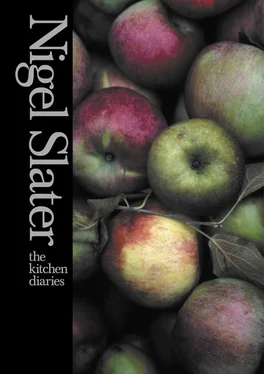Cheese-smothered potatoes Cheese-smothered potatoes waxy potatoes – 500g olive oil – 2 tablespoons butter – 50g a medium-sized onion, sliced garlic – 2 large cloves, finely sliced thyme leaves – 1 tablespoon, chopped easy melting cheese such as Taleggio or Fontina – 120g Rinse the potatoes. There is no need to peel them unless the skins are very tough. Slice them thinly – about as thick as a pound coin. The thinner you slice them, the quicker they will cook. Put the olive oil and butter in a shallow pan about 25cm in diameter and cook the onion and garlic in it for about five minutes, until they start to soften. Add the potatoes, some pepper and salt and the thyme to the pan and toss gently in the cooking fat. Cover with a lid and cook over a low heat for twenty-five minutes, turning once. Test the cooked potatoes for tenderness. If the point of a knife slices into them easily, they are done. Slice the cheese thinly and lay it over the top of the potatoes. Cover the pan once more and continue cooking for a couple of minutes until the cheese has melted. Serve immediately, while the cheese is still soft and oozing. Enough for 2
A velvety soup for a clear, cold day January 13 A velvety soup for a clear, cold day Crisp, clear, and the sky looks like Sweden. One of those days when you get tricked by the bright, crystal sky and go out with one layer too few, then come home freezing cold. I had every intention of bringing back something for supper but, after eating Turkish mezze at lunch, come home empty handed and end up scouring the fridge and cupboards for something to eat. I never throw away Parmesan rinds. No matter how dry and cracked they get, the craggy ends are full of intense, cheesy flavour. A more organised cook would freeze theirs; mine tend to collect in one of the little plastic drawers in the fridge door, the one you are supposed to keep eggs in. To get the full, soothingly velvet texture of this soup, you will need a couple of large hunks of rind, about 5-6cm long. If the fridge is bare, then ask at your local deli. They may let you have them for little or nothing. good-sized leeks – 3 butter – a thick slice, about 40g potatoes – 3 medium-sized Parmesan rinds light stock or water – 1.5 litres parsley – a handful grated Parmesan – 6 tablespoons Trim the leeks, slice them into thick rings, then wash thoroughly under cold running water. Melt the butter in a heavy-based pan (I use a cast-iron casserole), then tip in the washed leeks and let them soften slowly, covered with a lid, over a low to moderate heat. After about twenty minutes and with some occasional stirring they should be silkily tender. While they are softening, peel the potatoes and cut them into chunks. Add them to the leeks when they are soft and let them cook for five minutes or so, before dropping in the cheese rinds and pouring in the stock or water. Season with salt and black pepper, then partially cover and leave to simmer for a good forty minutes. Remove and discard the undissolved cheese rinds, scraping back into the soup any cheesy goo from them as you go. Add the leaves of the parsley and blitz the soup in a blender. Check the seasoning – it may need a surprisingly generous amount of salt and pepper – then bring briefly to the boil. Serve piping hot, with the grated Parmesan. Enough for 6
Bulghur wheat with aubergines and mint Bulghur wheat with aubergines and mint Bulghur is one of those mild, warming grains that soothes and satisfies. I value it for its knubbly texture and nutty flavour. This, to me, is supper, but others may like to use it beside something else, such as grilled chicken or a gravy-rich stew. olive oil – 6 tablespoons a small onion a bay leaf aubergines – 2 small ones garlic – 2 large cloves, chopped bulghur wheat – 225g vegetable stock – 500ml tomatoes – 4 pine kernels – 3 tablespoons, toasted mint – 15-20 leaves, chopped lemon juice to taste Warm the olive oil in a shallow pan, peel and finely slice the onion and let it cook slowly in the oil with the bay leaf. When the onion is soft and pale gold, add the aubergines, cut into 3cm pieces, and the chopped garlic. Let the aubergines cook, adding more oil if necessary, until they are golden and soft. Pour in the bulghur wheat and the vegetable stock. Bring to the boil, then leave to simmer gently for fifteen to twenty minutes, till the wheat is tender and almost dry. Half way through cooking, roughly chop the tomatoes and add them. Once the wheat is cooked (it should still be nutty and have some bite), stir in the toasted pine kernels and chopped mint leaves. Check the seasoning; it will need lemon juice, salt and pepper. Enough for 2, with seconds
A really good spaghetti Bolognaise A really good spaghetti Bolognese butter – 50g cubed pancetta – 70g a medium onion garlic – 2 fat cloves a carrot celery – 2 stalks flat mushrooms – 2 large, about 100g bay leaves – 2 minced beef or lamb – 400g crushed tomatoes or passata – 200ml red wine – 200ml stock – 200ml a nutmeg full-cream milk or cream – 200ml To serve: spaghetti or tagliatelle for 4 grated Parmesan Melt the butter in a heavy-based pan – I use a cast-iron one about 24cm in diameter – then stir in the pancetta and let it cook for five minutes or so, without colouring much. Meanwhile peel and finely chop the onion and garlic and stir them into the pancetta. Scrub and finely chop the carrot and celery and stir them in, too. Lastly, finely chop the mushrooms and add to the pan, then tuck in the bay leaves and leave to cook for ten minutes over a moderate heat, stirring frequently. Turn up the heat and tip in the meat, breaking it up well with a fork. Now leave to cook without stirring for a good three or four minutes, then, as the meat on the bottom is starting to brown, stir again, breaking up the meat where necessary, and leave to colour. Mix in the tomatoes, red wine, stock, a grating of nutmeg and some salt and black pepper, letting it come to the boil. Turn the heat down so that everything barely bubbles. There should be movement, but one that is gentle, not quite a simmer. Partially cover the pan with a lid and leave to putter away for an hour to an hour and a half, stirring from time to time and checking the liquid levels. You don’t want it to be dry. Pour in the milk or cream a bit at a time, stir and continue cooking for twenty minutes. Check the seasoning, then serve with the pasta and grated Parmesan. Enough for 4
Chicken broth with noodles, lemon and mint Chicken broth with noodles, lemon and mint dried egg noodles – 50g very good chicken broth – 1 litre cooked chicken (leftover roast is fine) – 200g chopped mint leaves – 2 heaped tablespoons roughly chopped coriander leaves – 2 heaped tablespoons the juice of a lemon Drop the noodles into a deep pan of boiling, salted water and cook for two to three minutes, until tender. Drain them, rinse under cold running water, then leave to cool in a bowl of cold water until you need them. Bring the chicken broth to the boil, then turn the heat down to a simmer. Shred the chicken with a sharp knife and add it to the simmering broth with the mint, coriander and lemon juice. Add the noodles, leave for one minute, then serve steaming hot in big bowls. Enough for 2 as a main dish
Spiced crumbed mackerel with smoked paprika Spiced crumbed mackerel with smoked paprika mackerel – 4, filleted onion – 1 medium to large olive oil parsley – a handful garlic – 3 small cloves smoked ‘hot’ paprika – half a teaspoon fresh breadcrumbs – 100g a lemon Rinse and dry the mackerel fillets and lay them skin-side down in a lightly oiled dish. Season them lightly with salt and pepper. Set the oven at 180°C/Gas 4. Peel the onion and slice it into very thin rings, then let it cook over a moderate heat in a couple of tablespoons of olive oil until it starts to soften. Chop the parsley, not too finely, then peel and crush the garlic and stir into the onion with the paprika, a seasoning of black pepper and salt and the breadcrumbs. Pour in three tablespoons of olive oil. Spoon the spiced breadcrumbs evenly over the fish and bake for twenty minutes. It is ready when the crumbs are golden and the fish is opaque and tender. Lift on to plates using a fish slice, then squeeze the lemon over each one. Enough for 4
Читать дальше












